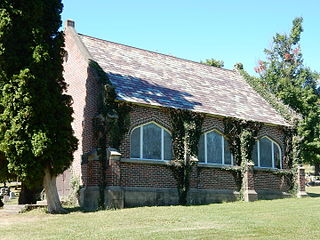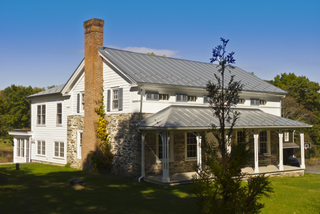
New Utrecht Reformed Church is the fourth oldest Reformed Church in America congregation and is located in Bensonhurst, Brooklyn, New York. The church was established in 1677 by ethnic Dutch residents in the town of New Utrecht, Brooklyn, several years after the English took over New Netherland. It is affiliated with the Reformed Church in America, a Protestant denomination. The cemetery was consecrated in 1654; 1300 dead are interred there. The Liberty Pole, the sixth on the site of the present church, was originally erected in 1783 at the end of the Revolutionary War to harass departing British troops.

This is intended to be a complete list of properties and districts listed on the National Register of Historic Places in Orleans County, New York. The locations of National Register properties and districts may be seen in a map by clicking on "Map of all coordinates". Two listings, the New York State Barge Canal and the Cobblestone Historic District, are further designated a National Historic Landmark.

George and Addison Wheeler House, also known as Old Place, is a historic home located at East Bloomfield in Ontario County, New York. The Greek Revival–style home was built in two sections in about 1818 and 1840. The 2-story main block from 1840 features a temple front with a massive, pedimented portico. Behind it stands a 1 1⁄2-story wing that was the original saltbox-style home constructed about 1818. Also on the property is a 19th-century barn / carriage house and a small family cemetery. Abandoned for a generation, it was restored in the late 1940s by William and Marie Houghton.

Asbury United Methodist Church and Bethel Chapel and Cemetery is a national historic district containing a Methodist church, chapel, and cemetery at 19 Old Post Road in Croton-on-Hudson, Westchester County, New York. The church was built in 1883 and is a rectangular brick building with a multi-colored slate-covered gable roof in the Gothic Revival style. It features large Gothic-arched stained and leaded glass windows added in 1891 and a square, engaged, two stage tower. The chapel was built about 1790 and is a 1 1⁄2-story, two-by-two-bay, clapboard-sided building on a granite foundation. Francis Asbury (1745–1816) is known to have visited the chapel on September 20, 1795. The cemetery is in two sections and contains about 5,000 graves; the date of the earliest burial is 1801. It includes the grave of noted playwright and author Lorraine Hansberry (1930–1965).

Lake View Cemetery is a historic cemetery located at Penn Yan in Yates County, New York. It is a 50-acre (20 ha) cemetery property that includes wooded and open acres included in the cemetery's historic landscape plan and developed in two phases between about 1855 and 1906. The property includes the Abraham Wagener Memorial Chapel, a two-story brick Gothic Revival structure built in 1923-1924. It was listed on the National Register of Historic Places in 1996.

German Presbyterian Church and Hortonville Cemetery, also known as Hortonville Presbyterian Church, is a historic Presbyterian church and cemetery located at CR 121 and CR 131 in Hortonville, Sullivan County, New York. The church was built about 1860 and is a one-story, rectangular wood frame building, 27 feet long and 41 feet wide. It features a steep gable roof with two stage tower and small spire. The cemetery is located about a quarter mile from the church and contains approximately 100 stones. The cemetery contains the stone foundation of the original meeting house.

Zion Episcopal Church Complex and Harmony Cemetery is a national historic district comprising a historic Episcopal church complex and cemetery located at Morris in Otsego County, New York. The complex consists of the church, rectory (1893), and parish house (1901). The church was built in 1818 and is a stone building in the early English Gothic Revival style. It features a steeply sloping gable roof and a central projecting bell tower with a belfry with a balustrade. The Harmony Cemetery has burials dating from about 1800 to 1937.

Crum Elbow Meeting House and Cemetery is a historic Society of Friends meeting house and cemetery in East Park, Dutchess County, New York. It was built in 1797, with an addition built about 1810. It is a two-story, white painted frame building with weather board siding and a moderately pitched gable roof. The surrounding rural cemetery contains plain Quaker style markers dated from about 1797 to 1890.

Oswego Meeting House and Friends' Cemetery is a historic Society of Friends meeting house and cemetery in Moore's Mill, Dutchess County, New York. It was built in 1790 and is a 1 1⁄2-story frame building sided with clapboards and wooden shingles. It has a moderately pitched gable roof and two entrances on the front facade, each flanked by two windows. The cemetery contains about 50 stones and burials range in date from the 1790s to 1880s. Also on the property is a privy.

First Old School Baptist Church of Roxbury and Vega Cemetery is a historic Baptist church and cemetery located at Roxbury in Delaware County, New York. The church was built in 1856 in a Greek Revival style and is a rectangular, front gabled frame building in the meeting house form.

Second Old School Baptist Church of Roxbury is a historic Baptist church building on City Rd. 41 in Roxbury, Delaware County, New York. It is a 2-story, three-by-four-bay wood-frame building constructed in 1832–1833. The interior features a traditional meeting house plan. Also on the property is a small frame outhouse built about 1870, a three-step fieldstone carriage step, and cemetery.

W.H. Dorrance House is a historic home located at Camden in Oneida County, New York. According to town records, it was built about 1880 and is an irregularly massed, 2 1⁄2-story wood-frame structure in the Queen Anne style. The architect was Utica, NY-based M.H. Hubbard. It features an engaged circular tower with conical roof.

Stilwell-Westbrook Stone House is a historic home located at Rochester in Ulster County, New York. It is a 1 1⁄2-story, five-bay stone dwelling built about 1750. Changes in the early 19th century added Greek Revival details. Also on the property is a large privy dated to about 1880.

Guilford-Bower Farm House is a historic home in New Paltz in Ulster County, New York. It was built about 1850 and is a large 2-story brick residence with a 1 1⁄2-story brick kitchen wing.

Teunis Houghtaling House, also known as Vredehuis, is a historic home located at Clarksville in Albany County, New York. It was built in two stages: the 1 1⁄2-story main block was built about 1770, expanded to a five-bay dwelling about 1790, at which time a 1-story addition was also completed. It is constructed of hand-hewn timber framing. Also on the property are two frame outbuildings and a small family cemetery with burials dating to the early 19th century.

Tobias Ten Eyck House and Cemeteries is a historic home and cemeteries located at Coeymans in Albany County, New York. It was built about 1758 and is a rectangular, 1 1⁄2-story brick dwelling on a coursed stone foundation. It is topped by a gambrel roof and end wall chimneys. The property includes two burial grounds; one for the Ten Eyck family and another for the family slaves.

Sharpe Homestead and Cemetery is a historic home and cemetery located at Defreestville in Rensselaer County, New York. The house was built about 1740 and is a 1 1⁄2-story rectangular frame dwelling, 20 feet by 40 feet, topped by a steeply pitched gable roof covered with standing seam metal. It rests on a low fieldstone foundation. The family cemetery contains approximately a dozen stones marking the graves of the Sharpe and Barringer families.

Dellemont–Wemple Farm is a historic farm complex located at Rotterdam in Schenectady County, New York. The complex consists of the farmhouse, Dutch barn, chicken house, and family cemetery. The brick, gambrel roofed Dutch style farmhouse was built about 1790 and sits on a stone foundation. The wood Dutch barn was built about 1770, or earlier.

White Plains Rural Cemetery is a historic cemetery located in the city of White Plains, Westchester County, New York. The cemetery was organized in 1854 and designed in 1855. It contains miles of narrow, paved roads, none of which is in a straight line. The roads create circular and lozenge-shaped areas for burials. Also on the property is a former church, now cemetery office. It was built in 1797, and is a 2 1⁄2-story, five-by-three-bay frame building with a high-pitched gable roof. It was modified for office use in 1881.

Terpenning–Johnson House and Cemetery is a historic home and family cemetery located at Brooker Hollow, Schoharie County, New York. The main block was built about 1845, and is a two-story, five bay, dwelling with a 1 1/2-story side wing built about 1810. Both sections have gable roofs rest on a stone foundation. Also on the property are the contributing family cemetery with burials dated from 1812 to 1873, garage, workshop, and barn (1840s).






















